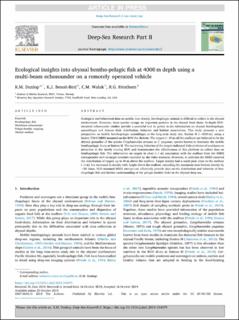| dc.contributor.author | Dunlop, Katherine Mary | |
| dc.contributor.author | Benoit-Bird, Kelly J | |
| dc.contributor.author | Waluk, Chad M | |
| dc.contributor.author | Henthorn, Richard G | |
| dc.date.accessioned | 2020-10-29T11:10:55Z | |
| dc.date.available | 2020-10-29T11:10:55Z | |
| dc.date.created | 2020-01-21T16:52:18Z | |
| dc.date.issued | 2019 | |
| dc.identifier.citation | Deep-sea research. Part II, Topical studies in oceanography. 2019, 1-6. | en_US |
| dc.identifier.issn | 0967-0645 | |
| dc.identifier.uri | https://hdl.handle.net/11250/2685685 | |
| dc.description.abstract | Ecological and behavioral data on mobile, low density, benthopelagic animals is difficult to collect in the abyssal environment. However, these species occupy an important position in the abyssal food chain. At-depth ROV-mounted echosounder studies provide a powerful tool to gather in-situ information on abyssal benthopelagic assemblages and discern their distribution, behavior and habitat associations. This study presents a new perspective on mobile benthopelagic assemblages at the long-term study site, Station M (∼4000 m), using a Seabat T20-S MBES mounted on the ROV Doc Ricketts. The targets (∼45 m off the seafloor) are believed to be the abyssal grenadier of the species Coryphaenoides armatus or C. yaquinae, species known to dominate the mobile benthopelagic fauna at Station M. The swimming behavior of the targets indicated little evidence of avoidance or attraction to the slowly moving ROV and demonstrates the effectiveness of this platform to collect data on benthopelagic fish. The information on targets in close (<1 m) association with the seafloor from the MBES corresponded well to target densities recorded by the video transects. However, in addition the MBES resolved the distribution of targets up to 45 m above the seafloor. Target density had a small peak close to the seafloor (<1 m) but increased in density with height above the seafloor, exceeding the maximum near-bottom density by ∼50 times. ROV-mounted MBES surveys can effectively provide data on the distribution and behavior of benthopelagic fish and further understanding of the pelagic-benthic links in the abyssal deep-sea. | en_US |
| dc.language.iso | eng | en_US |
| dc.title | Ecological insights into abyssal bentho-pelagic fish at 4000 m depth using a multi-beam echosounder on a remotely operated vehicle | en_US |
| dc.type | Peer reviewed | en_US |
| dc.type | Journal article | en_US |
| dc.description.version | acceptedVersion | en_US |
| dc.source.pagenumber | 1-6 | en_US |
| dc.source.journal | Deep-sea research. Part II, Topical studies in oceanography | en_US |
| dc.identifier.doi | 10.1016/j.dsr2.2019.104679 | |
| dc.identifier.cristin | 1779465 | |
| cristin.unitcode | 7431,0,0,0 | |
| cristin.unitname | Havforskningsinstituttet | |
| cristin.ispublished | true | |
| cristin.fulltext | postprint | |
| cristin.qualitycode | 1 | |
